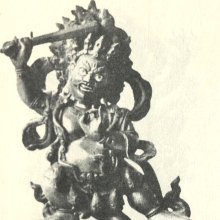Khadgadhara, Khaḍgādhāra, Khaḍgadhāra, Khaḍgadhara, Khaḍgadhārā, Khaḍgadharā, Khadga-dhara, Khadga-adhara: 10 definitions
Introduction:
Khadgadhara means something in Hinduism, Sanskrit, the history of ancient India. If you want to know the exact meaning, history, etymology or English translation of this term then check out the descriptions on this page. Add your comment or reference to a book if you want to contribute to this summary article.
Images (photo gallery)
In Hinduism
Kavya (poetry)
Source: Wisdom Library: KathāsaritsāgaraKhaḍgadhara (खड्गधर) is the name of a Kṣatriya from Dakṣiṇāpatha (the Deccan), desirous of obtaining Anaṅgarati, as mentioned in the Kathāsaritsāgara, chapter 52. Accordingly, “... I am a Kṣatriya named Khaḍgadhara, and no one surpasses me in fighting with the sword”.
Khaḍgadhara is also mentioned in the ninth story of the Vetālapañcaviṃśati in the Kathāsaritsāgara, chapter 83. Accordingly, as Khaḍgadhara said to king Vīradeva: “... I am a Kṣatriya king, by name Khaḍgadhara, renowned for might of arm: my equal in the art of swordmanship does not exist upon the earth, so bestow this maiden on me, O King”.
The Kathāsaritsāgara (‘ocean of streams of story’), mentioning Khaḍgadhara, is a famous Sanskrit epic story revolving around prince Naravāhanadatta and his quest to become the emperor of the vidyādharas (celestial beings). The work is said to have been an adaptation of Guṇāḍhya’s Bṛhatkathā consisting of 100,000 verses, which in turn is part of a larger work containing 700,000 verses.

Kavya (काव्य, kavya) refers to Sanskrit poetry, a popular ancient Indian tradition of literature. There have been many Sanskrit poets over the ages, hailing from ancient India and beyond. This topic includes mahakavya, or ‘epic poetry’ and natya, or ‘dramatic poetry’.
Shaktism (Shakta philosophy)
Source: Google Books: ManthanabhairavatantramKhaḍgadharā (खड्गधरा) is a synonym for Khaḍgadhāriṇī, or “she who holds a sword”, according to the Manthānabhairavatantra, a vast sprawling work that belongs to a corpus of Tantric texts concerned with the worship of the goddess Kubjikā.—Accordingly, “(Jvālāmaṅgalyā), the goddess born of Jāla is very dignified and powerful. She has five faces, four arms, and sits on a white lion. She holds sword, club [i.e., khaḍgadhāriṇī—khaḍgakheṭakadhāriṇī], fetter, and goad and is adorned with jewels. She wears clothes of various colours, is fierce and, when worshipped, bestows boons”.

Shakta (शाक्त, śākta) or Shaktism (śāktism) represents a tradition of Hinduism where the Goddess (Devi) is revered and worshipped. Shakta literature includes a range of scriptures, including various Agamas and Tantras, although its roots may be traced back to the Vedas.
Shaivism (Shaiva philosophy)
Source: Google Books: Manthanabhairavatantram (shaivism)Khaḍgadhara (खड्गधर) refers to “one who holds a sword” and represents one of the attributes of Svacchanda, according to the Śrīmatottara-tantra, an expansion of the Kubjikāmatatantra: the earliest popular and most authoritative Tantra of the Kubjikā cult. Accordingly, “O goddess, Svacchanda is in the middle, within the abode of the triangle. Very powerful, he has five faces with three times five flaming eyes. [...] O fair lady, my attributes—trident, dagger, sword [i.e., khaḍgadhara], the king of the snakes, and rosary—adorn the right (arms). O beloved, a skull, double-headed drum, javelin, noose and goad—(these) are my divine, brilliant and very auspicious weapons that (are held) in the left (hands). The king of snakes (hangs) on the shoulder and a garland of skulls hangs (from the neck). There is a necklace of scorpions around the throat and the ears are adorned with snakes. [...]”.

Shaiva (शैव, śaiva) or Shaivism (śaivism) represents a tradition of Hinduism worshiping Shiva as the supreme being. Closely related to Shaktism, Shaiva literature includes a range of scriptures, including Tantras, while the root of this tradition may be traced back to the ancient Vedas.
India history and geography
Source: Cologne Digital Sanskrit Dictionaries: Indian Epigraphical GlossaryKhadgadhara.—cf. Mahākhaḍgadhara, Khaḍagrāhin, etc. Note: khadgadhara is defined in the “Indian epigraphical glossary” as it can be found on ancient inscriptions commonly written in Sanskrit, Prakrit or Dravidian languages.

The history of India traces the identification of countries, villages, towns and other regions of India, as well as mythology, zoology, royal dynasties, rulers, tribes, local festivities and traditions and regional languages. Ancient India enjoyed religious freedom and encourages the path of Dharma, a concept common to Buddhism, Hinduism, and Jainism.
Languages of India and abroad
Sanskrit dictionary
Source: DDSA: The practical Sanskrit-English dictionaryKhaḍgādhāra (खड्गाधार).—a sheath, scabbard.
Derivable forms: khaḍgādhāraḥ (खड्गाधारः).
Khaḍgādhāra is a Sanskrit compound consisting of the terms khaḍga and ādhāra (आधार).
--- OR ---
Khaḍgadhara (खड्गधर).—a swordsman.
Derivable forms: khaḍgadharaḥ (खड्गधरः).
Khaḍgadhara is a Sanskrit compound consisting of the terms khaḍga and dhara (धर).
--- OR ---
Khaḍgadhārā (खड्गधारा).—a sword-blade; खड्गधारा हता मेऽय दीप्यमाना इवाग्नयः (khaḍgadhārā hatā me'ya dīpyamānā ivāgnayaḥ) Rām.2.23.34. °व्रतम् (vratam) an extremely difficult task.
Khaḍgadhārā is a Sanskrit compound consisting of the terms khaḍga and dhārā (धारा).
Source: Cologne Digital Sanskrit Dictionaries: Cappeller Sanskrit-English DictionaryKhaḍgadhara (खड्गधर).—[adjective] bearing a sword; [masculine] a man’s name.
Source: Cologne Digital Sanskrit Dictionaries: Monier-Williams Sanskrit-English Dictionary1) Khaḍgadhara (खड्गधर):—[=khaḍga-dhara] [from khaḍga] m. a swordsman, [Horace H. Wilson]
2) [v.s. ...] Name of a soldier, [Kathāsaritsāgara]
3) Khaḍgadhārā (खड्गधारा):—[=khaḍga-dhārā] [from khaḍga] f. a sword-blade, [Rāmāyaṇa ii, 23, 35]
4) Khaḍgādhāra (खड्गाधार):—[from khaḍga] m. ‘sword-holder’, scabbard, [Horace H. Wilson]
Source: Cologne Digital Sanskrit Dictionaries: Yates Sanskrit-English Dictionary1) Khaḍgadhara (खड्गधर):—[khaḍga-dhara] (raḥ) 1. m. A swordsman.
2) Khaḍgādhāra (खड्गाधार):—[khaḍgā+dhāra] (raḥ) 1. m. Scabbard.
[Sanskrit to German]
Sanskrit, also spelled संस्कृतम् (saṃskṛtam), is an ancient language of India commonly seen as the grandmother of the Indo-European language family (even English!). Closely allied with Prakrit and Pali, Sanskrit is more exhaustive in both grammar and terms and has the most extensive collection of literature in the world, greatly surpassing its sister-languages Greek and Latin.
See also (Relevant definitions)
Partial matches: Khadga, Dhara, Adhara.
Starts with: Khadgadharavrata.
Ends with: Mahakhadgadhara.
Full-text: Khadgadharavrata, Mahakhadgadhara.
Relevant text
Search found 3 books and stories containing Khadgadhara, Khaḍgādhāra, Khaḍgadhāra, Khaḍgadhara, Khaḍgadhārā, Khaḍgadharā, Khadga-dhara, Khadga-adhara, Khaḍga-ādhāra, Khaḍga-dhara, Khaḍga-dhārā, Khaḍga-dharā; (plurals include: Khadgadharas, Khaḍgādhāras, Khaḍgadhāras, Khaḍgadharas, Khaḍgadhārās, Khaḍgadharās, dharas, adharas, ādhāras, dhārās, dharās). You can also click to the full overview containing English textual excerpts. Below are direct links for the most relevant articles:
The Padma Purana (by N.A. Deshpande)
Chapter 154 - Khaḍgadhāreśvara (Khaḍgadhāra-īśvara) < [Section 6 - Uttara-Khaṇḍa (Concluding Section)]
Chapter 155 - Dugdheśvara < [Section 6 - Uttara-Khaṇḍa (Concluding Section)]
Kathasaritsagara (the Ocean of Story) (by Somadeva)
Nitiprakasika (Critical Analysis) (by S. Anusha)

